Tangier is a meeting point of civilizations and the confluence of two seas, and this diversity is reflected in the traditional products you’ll find in its markets and shops, which bear the imprint of history and authentic Moroccan craftsmanship. Whether you’re looking for a unique artistic piece, a special gift, or a souvenir that carries the spirit of Morocco, the traditional products of Tangier will captivate you with their diversity, beauty, and authenticity.
In this comprehensive guide, we’ll take you on an exploratory journey of the most beautiful and remarkable traditional products of Tangier, from elegant clothing and dazzling textiles to metal and wooden objects, enchanting Amazigh jewelry, and natural cosmetic products. We’ll also guide you to the best places to shop and provide practical tips to ensure an enjoyable and successful shopping experience.
Traditional Clothing and Textiles of Tangier
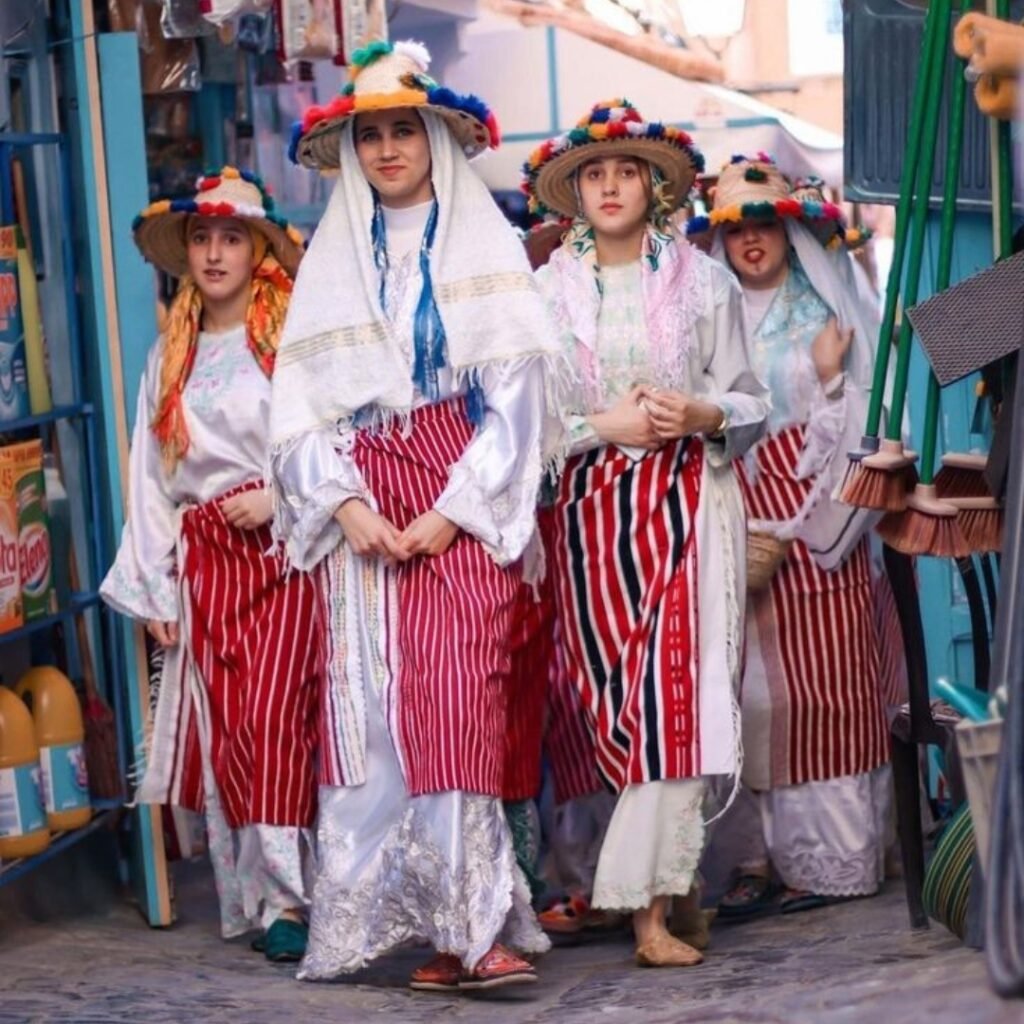
Clothing and textiles form an essential part of Tangier’s traditional products, reflecting the elegance and rich Moroccan heritage with its vibrant colors and unique designs. They can be acquired as exceptional pieces that add an authentic Moroccan touch to your wardrobe.
The Moroccan Djellaba and Caftan (Traditional Clothing)
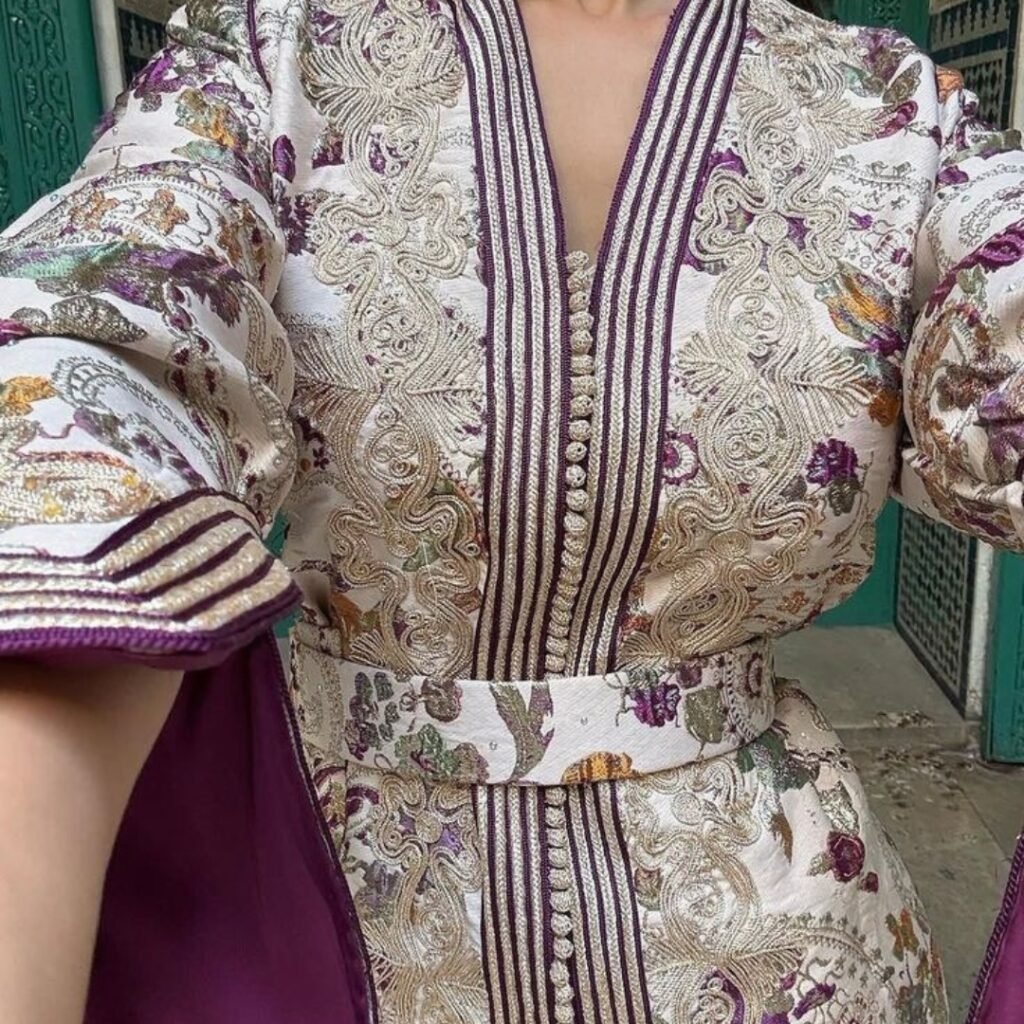
The Moroccan djellaba is a loose traditional garment worn by both men and women, characterized by a pointed hood (the qalenswa) and long sleeves. In Tangier, the djellaba is made from various materials including cotton, linen, warm wool for winter, and lightweight fabrics for summer. Djellaba designs range from simple single-colored ones to those adorned with intricate hand embroidery.
As for the Moroccan caftan, it is a more elegant and formal garment, usually worn for special occasions such as weddings and celebrations. The caftan is distinguished by its refined designs and intricate gold or silver embroidery (known as “tanbat” or “akad”) that reflect the skill of Moroccan craftsmen. In Tangier’s markets, you can find a wide range of caftans in various colors, patterns, and materials to suit all tastes and budgets.
What distinguishes traditional clothing in Tangier is the possibility of buying ready-made pieces or ordering a special tailoring to your measurements and personal taste, where you can choose the fabric, design, and type of embroidery.
Textiles and Carpets (Rugs)
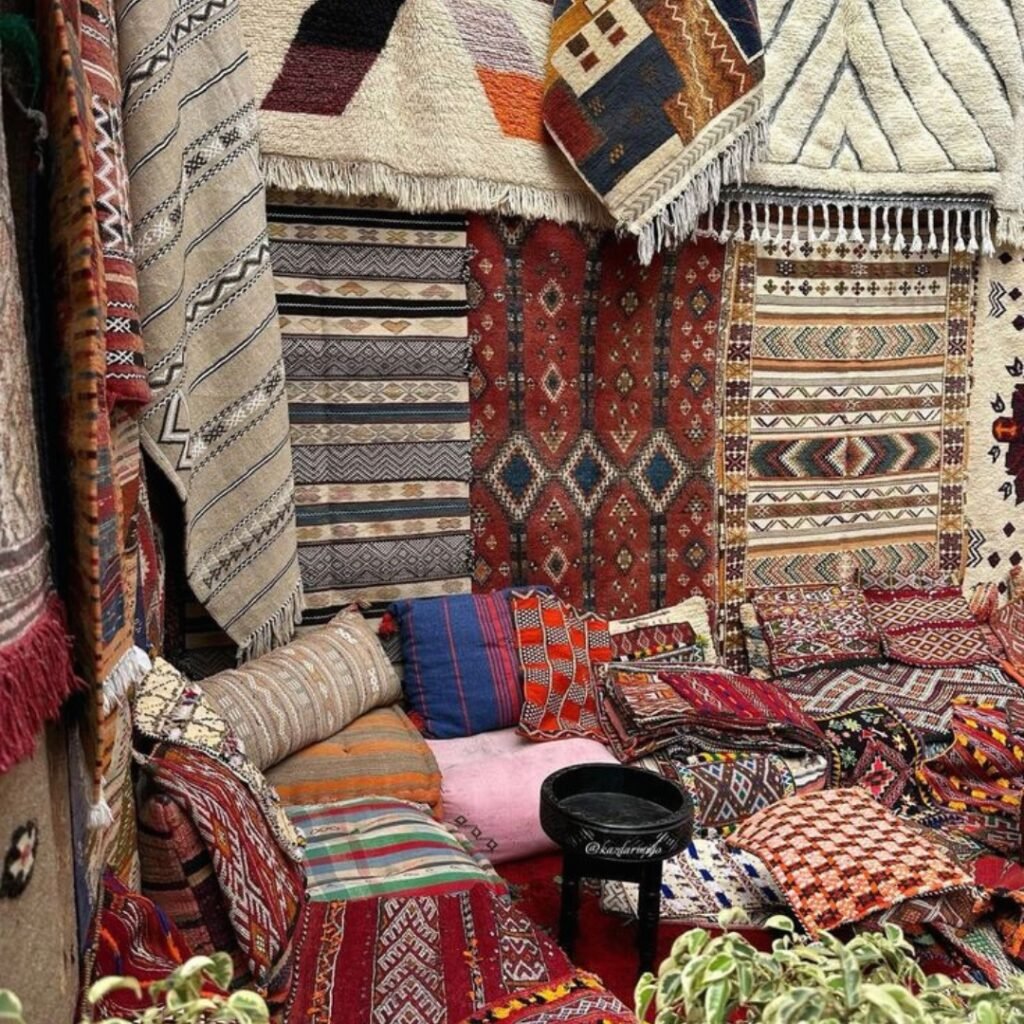
Moroccan carpets (rugs) are among the most famous traditional products that can be acquired in Tangier, distinguished by their vibrant colors and geometric or floral patterns inspired by nature and Moroccan culture. The carpets available in Tangier’s markets vary between:
- Amazigh (Berber) carpets: Generally thick with simple geometric patterns and Amazigh symbols passed down through generations.
- Kilim carpets: Thin and flat, ideal for use in warm weather.
- Urban carpets: With more complex designs and harmonious colors, reflecting the character of ancient Moroccan cities.
Most of these carpets are made of natural wool, sometimes mixed with cotton, and their manual weaving can take weeks or months depending on their size and design complexity. In addition to carpets, you can find other textiles such as tablecloths, decorated cushions, and hand-woven blankets, which make excellent additions to interior decoration.
Leather Articles and Traditional Shoes
Leather products are renowned in Morocco, and you’ll find them in Tangier in various forms, notably the traditional babouches (slippers) which are among the most popular traditional products with tourists and visitors.
Babouches (Traditional Leather Shoes)
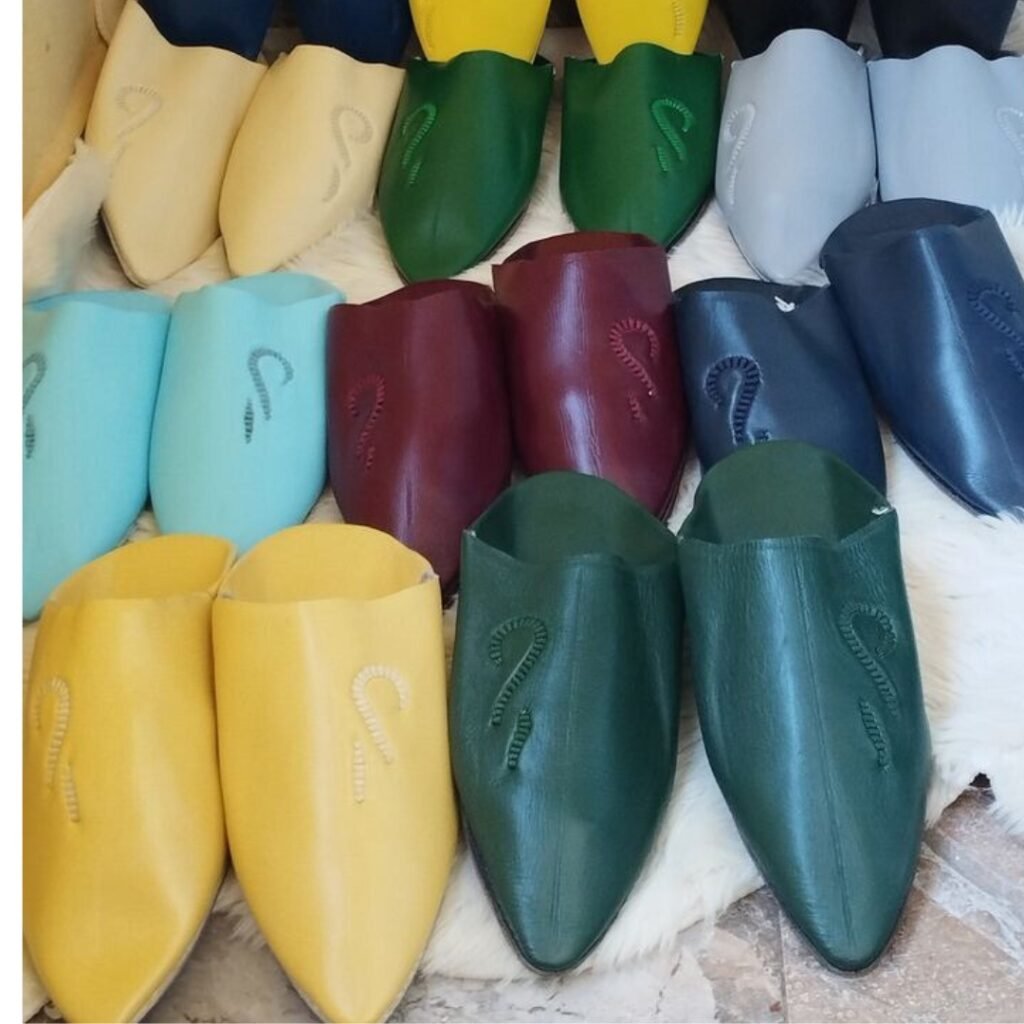
Moroccan babouches are traditional flat shoes, made of soft natural leather, characterized by their pointed or round toe and comfortable design that makes them easy to slip on and off. Babouches are made in a traditional way in specialized workshops, and can be found in Tangier’s markets in a wide range of colors and designs:
- Traditional single-colored babouches (usually yellow or red for women, brown or black for men).
- Babouches embroidered with colored threads or gold and silver threads for special occasions.
- Babouches adorned with sequins, beads, or colored glass stones.
Moroccan babouches make an ideal gift or a lightweight and practical souvenir to bring back from Tangier, usable as comfortable indoor shoes or as decorative pieces adding an authentic Moroccan touch.
Other Leather Products
In addition to babouches, Tangier’s markets offer a variety of traditional leather products that stand out for their high quality and durability, notably:
- Leather bags: Available in different sizes and designs, from small shoulder bags to large travel bags.
- Wallets and belts: Made of goat or camel leather, often decorated with traditional patterns.
- Poufs: These are circular seats made of embroidered leather, used as traditional furniture in Moroccan homes.
- Book covers and notebooks: Covered with leather and decorated with Islamic or Amazigh patterns.
Moroccan leather is distinguished by its natural color and characteristic scent, it is tanned and dyed using traditional methods in ancient tanneries, giving it unique characteristics in terms of durability and flexibility.
Metal, Wooden Objects and Decoration Items
To add an authentic Moroccan touch to your home, Tangier offers a range of traditional products made of wood, metal, and ceramics, which reflect the craftsmanship of Moroccan artisans and their rich heritage.
Wood Carving and Engraving (Wooden Products)
Wood carving is one of the oldest crafts in Morocco, and is manifested in various wooden products available in Tangier’s markets. Artisans use different types of wood, notably cedar known for its aromatic scent and sturdy walnut, and sometimes thuya (although the latter is more common in Essaouira).
Among the main traditional wooden products in Tangier:
- Decorated wooden boxes: Used to store jewelry or precious objects, and adorned with delicate geometric or floral patterns.
- Moucharabiehs: Windows or partitions made of fretted wood that allow the passage of light and air while preserving privacy.
- Carved wooden furniture: Such as tables, chairs, and sofas decorated with Islamic or Amazigh patterns.
- Carved wooden panels: Used as wall decorative pieces that add an authentic touch to the home.
Moroccan wood carving is characterized by its extreme precision and the use of multiple techniques such as carving, inlaying, and fretwork, reflecting a skill deeply rooted in Moroccan Islamic heritage.
Copper, Silver Products and Metallic Objects
Metal objects occupy an important place among the traditional products of Tangier, particularly those made of copper, silver, and brass. Artisans shape these metals and decorate them using various techniques such as hammering, engraving, and piercing, to produce magnificent artistic pieces such as:
- Moroccan lanterns: Made of perforated metal and colored glass, hung as decorative lighting casting magical shadows.
- Trays and teapots: Traditional utensils used to serve Moroccan tea, characterized by their delicate decorations.
- Decorative plates: Made of copper or brass and adorned with Islamic or geometric patterns.
- Decorated mirrors: Surrounded by engraved metal frames, constituting an elegant addition to interior decoration.
These metal products reflect ancestral traditions in Tangier and Morocco, combining practical functionality and aesthetic value.
Ceramics (Plates, Tagines, etc.)
Moroccan ceramics are among the globally recognized traditional products, and although the city of Fez is the main center for their manufacture, Tangier’s markets offer a variety of ceramic pieces from different regions of Morocco. These products are distinguished by their vibrant colors (notably blue, green, and yellow) and their meticulous geometric or floral patterns.
Among the most famous ceramic products available in Tangier:
- Plates and bowls: Of different sizes and shapes, used for serving or as decorative pieces.
- Tagines: Traditional cooking utensils composed of a flat base and a conical lid, used to prepare famous Moroccan dishes.
- Vases: In various designs, perfect for displaying flowers or as decorative pieces.
- Tea and coffee sets: Including teapots, cups, and saucers decorated in matching colors.
Moroccan ceramics are made according to a traditional method that requires great skill, from shaping the clay to painting, decorating, and glazing which gives it its characteristic shine.
Amazigh Silver Jewelry: Heritage and Elegance
Amazigh silver jewelry is among the most wonderful traditional products you’ll find in Tangier, reflecting a long history of craftsmanship and symbolism in Amazigh culture (the original inhabitants of Morocco).
These jewels are distinguished by their bold designs and relatively large size, mainly made of silver sometimes inlaid with colored enamel, beads, old coins, or pieces of glass. Each piece of Amazigh jewelry has its own meaning, they are not merely ornaments, but symbols of identity, protection, and social status.
Among the most famous pieces of Amazigh silver jewelry available in Tangier:
- The fibula (or khlala): A large traditional brooch used to attach clothing, considered a symbol of protection.
- Bracelets and anklets: Often wide, heavy, and adorned with geometric patterns.
- Necklaces: Multi-layered and decorated with coins or stones, reflecting the wealth and elegance of the wearer.
- Earrings: Large and adorned with minute details, often in the shape of a crescent.
- Rings: Set with precious or semi-precious stones such as agate or coral.
You can find authentic Amazigh silver jewelry in Tangier’s specialized markets or from reputable silversmiths. They make a valuable gift or a unique souvenir carrying a part of authentic Moroccan heritage.
Traditional Cosmetic Products and Argan Oil
The world of traditional products in Tangier is not limited to tangible crafts, but also includes natural and healthy products used in cosmetics and body care, based on natural ingredients and traditional techniques passed down through generations.
Argan Oil and its Derivatives
Argan oil is Morocco’s “liquid gold,” extracted from the fruits of the argan tree which grows mainly in southern Morocco, especially in the Souss region. Although Tangier is not an argan oil production region, it is widely available in its markets and herbal shops.
Argan oil is used in two main ways:
- For cosmetics: Used to moisturize the skin, strengthen hair, and treat skin problems such as acne and wrinkles, due to its richness in antioxidants and vitamin E.
- For cooking: Characterized by a distinctive nutty flavor, used in Moroccan cuisine to prepare certain dishes, for dipping with bread, or to make “amlou” (a paste made from argan oil, almonds, and honey).
When buying argan oil in Tangier, make sure to choose an authentic product from reliable sources, and note that there are two types: food argan oil (roasted) and cosmetic argan oil (unroasted).
Other Traditional Cosmetic Products
In addition to argan oil, herbal shops in Tangier offer a variety of traditional Moroccan cosmetic products, notably:
- Kohl: A black powder used as traditional eye makeup, reputed to strengthen eyesight and protect the eyes from the sun’s rays.
- Henna: A vegetable powder used to dye hair a natural red-brown color, or to draw temporary patterns on hands and feet.
- Beldi soap: A natural soap made from black olive oil, used in the Moroccan hammam (bath) to clean and soften the skin.
- Rose water: A scented liquid extracted from rose petals, used to purify and soothe the skin, as well as to scent desserts and drinks.
- Ghassoul: A natural clay used as a mask for hair and skin, helping to clean the skin and soften the hair.
These products can be found in herbal shops spread throughout the old city of Tangier, which also offer various medicinal herbs and essential oils.
Craftsmanship and Authenticity of Traditional Products in Tangier
The traditional products of Tangier reflect the skill and creativity of Moroccan artisans who have inherited their crafts through successive generations. Each piece, whether it’s an embroidered djellaba, a carved piece of wood, a copper tray, or an Amazigh silver necklace, is the fruit of long hours of meticulous and expert work.
Traditional crafts in Tangier draw their spirit from a unique mix of cultures and influences: Amazigh, Arab, Andalusian, African, and Mediterranean. The secrets of these crafts are passed from father to son, or from master to apprentice, in small workshops often attached to businesses.
What distinguishes the shopping experience in Tangier is the possibility of observing artisans at work in some parts of the market, offering visitors the opportunity to appreciate the effort and skill behind each piece. Watching the sculptor carve wood, the silversmith shape silver, or the weaver weave a carpet, is an experience that adds a new dimension to exploring traditional products of Tangier.
Where to Shop for Traditional Products in Tangier? Guide to Markets and Shops
To find these traditional products in Tangier and acquire unique pieces, the main destination is Tangier’s markets, in addition to other varied options that suit different tastes and budgets.
Tangier Markets (Traditional Souks)
The traditional markets of the old city (medina) of Tangier are the ideal destination for shopping and buying traditional products. The shopping journey usually starts from April 9th Square (also known as Grand Socco), then towards Souk Dakhil and Bab Al Bahr.
Tangier’s markets are distinguished by their lesser complexity and crowdedness compared to the markets of Fez or Marrakech, making the shopping experience more enjoyable and less tiring for visitors. These markets are divided into specialized areas:
- The textile and clothing souk: Where you’ll find djellabas, caftans, carpets, and traditional textiles.
- The leather souk: Specialized in babouches and other leather products.
- The copper smiths’ souk: Where copper and metal objects such as trays and lanterns are sold.
- The jewelry souk: Specialized in Amazigh silver jewelry and other ornaments.
- The carpenters’ souk: Where carved wooden products are displayed.
These markets combine the authenticity of products and their diversity, and offer the opportunity to interact directly with sellers and craftsmen.
Herbalist Shops
Herbal shops are the ideal destination for buying traditional cosmetic products and authentic argan oil. These shops are widespread in the old city, particularly near the main markets, and are distinguished by their shelves filled with medicinal herbs, essential oils, and natural cosmetic products.
Herbal shop owners generally possess extensive knowledge of the benefits of their products and ways to use them, and can provide valuable advice to customers. Some shops allow visitors to try products before buying them.
Art Galleries and High-End Craft Shops
For those looking for high-quality traditional products at fixed prices (without the need to negotiate), art galleries and high-end craft shops in Tangier offer an appropriate option. These shops are located either on the edge of the old city or in the new city, and offer carefully selected products from skilled craftsmen.
These stores are distinguished by their presentation of traditional products in a modern and elegant environment, emphasizing quality of manufacture and design. They often provide authenticity certificates for the most precious products such as Amazigh silver jewelry or rare carpets.
Argan Cooperatives (Outside the City)
For those who wish to have an authentic experience and learn more about argan oil production, it is possible to visit argan cooperatives located on roads outside Tangier, particularly in the direction of Cap Spartel or on the road to the south.
In these cooperatives, generally managed by rural women, you can observe the process of extracting argan oil using traditional methods, from crushing hard argan fruits and extracting almonds, to grinding and pressing them to extract the oil. You can also buy argan oil and its derivatives directly from the source, thus ensuring the quality and authenticity of the product.
The Shopping Experience in Tangier: Bargaining and Practical Tips
Shopping in Tangier’s markets is a pleasant experience, and to make it successful, here are some practical tips that will help you enjoy it and obtain the best traditional products at reasonable prices.
The Art of Bargaining: Expect to Negotiate in Traditional Markets
Bargaining (negotiation) is an essential part of shopping culture in Moroccan markets, including those of Tangier. Unlike luxury shops or art galleries with fixed prices, prices in traditional markets are negotiable, and it is even expected that you negotiate them.
Here are some tips for mastering the art of bargaining in Tangier’s markets:
- Start by familiarizing yourself with the market and prices: Before buying, walk around the market and inquire about prices of similar products from several sellers to get an idea of the fair price.
- Offer a lower price: When showing interest in a product, offer a price equivalent to approximately 30-40% of the asked price, then negotiate progressively.
- Be friendly and courteous: Bargaining is a social exchange, not a battle. Smiling and kindness help to get a better price.
- Don’t show excessive enthusiasm: If you show too keen an interest in a particular item, it will be difficult to negotiate its price.
- Be ready to walk away: Sometimes, walking away and coming back later can be an effective strategy to get a better price.
- Use expressions like: “ghali bezzaf” (too expensive) or “shwiya naqas” (lower it a bit) in a friendly manner.
Bargaining in Tangier differs slightly from that in Marrakech or Fez, it is less intense and more direct, due to the influence of European cultures on the city.
Payment Options
When shopping for traditional products in Tangier, it’s useful to know the available payment options:
- Cash (Moroccan dirham): The best option for shopping in traditional markets and small shops, where most do not accept credit cards.
- Credit cards: Accepted in luxury shops, art galleries, and some large stores in the new city.
- Foreign currencies: Some sellers may accept the euro or dollar, but usually at an unfavorable exchange rate.
It is advisable to carry enough cash, especially when visiting traditional markets, while keeping it in a safe place due to crowding in some areas.
Moving Around in the Old City Markets
Tangier’s markets are less complex and branched compared to those of Fez or Marrakech, but they remain a maze of narrow alleys that can be difficult to navigate for a first-time visitor. Here are some tips for moving around easily:
- Use mapping applications: You can download a map of the old city and use it offline.
- Set reference points: Use prominent landmarks as reference points (such as the Kasbah, April 9th Square, or Bab Al Bahr).
- Seek help from a local guide: You can use an official tourist guide for a short tour of the markets.
- Trust your intuition: Don’t be afraid to get lost a little, as sometimes the most beautiful discoveries are made in unplanned alleys.
Remember that the old city of Tangier is relatively safe during the day, but it’s preferable to finish shopping before nightfall, especially in alleys away from the main tourist areas.
Checking Quality and Authenticity
To ensure obtaining authentic and high-quality traditional products in Tangier, here are some tips:
- Examine the product well: Carefully inspect pieces for manufacturing defects, particularly in stitching and embroidery for clothing, and engravings for wooden and metal products.
- Leather and fabric: Ensure the quality of materials, such as the softness of leather and color stability in textiles.
- Silver jewelry: Look for a stamp or hallmark indicating the purity of silver, and buy from reliable shops.
- Argan oil and cosmetic products: Buy them from reputable herbalists, pharmacies, or official cooperatives to ensure their purity and effectiveness.
- Ask about the origin of the product: Don’t hesitate to ask the seller about the source of the product and how it was made, honest sellers will be proud to share this information.
Remember that authentic and handmade products may contain some minor “defects” that distinguish them from industrially manufactured products, which is part of their charm and uniqueness.
Conclusion: Traditional Products of Tangier… Treasures of Craftsmanship, Art, and Beauty
The traditional products of Tangier represent a cultural and artistic treasure that reflects the richness and diversity of Moroccan heritage. From traditional clothing like the djellaba and caftan, to luxurious textiles and ornate carpets, leather articles such as babouches, carved wooden products, exquisite copper and silver objects, to Amazigh silver jewelry and natural cosmetic products like argan oil.
The shopping experience in Tangier’s markets is not just an opportunity to acquire these unique products, but a journey into a world of colors, smells, and sounds, and a chance to interact with an ancestral culture and inherited traditions. The narrow alleys, talented artisans, the art of bargaining, all these elements make shopping in Tangier an unforgettable experience.
Whether you’re looking for an artistic piece to decorate your home, a special gift for a loved one, or a souvenir carrying the spirit of Morocco, the traditional products of Tangier will meet your expectations and captivate your heart with their beauty and authenticity. Don’t miss the opportunity to explore Tangier’s markets and discover its artisanal treasures, practice your bargaining skills, and acquire unique pieces that carry with them stories and memories of this enchanting city.
Share your experience with traditional products of Tangier, and tell us about your favorite discoveries and the pieces that captured your heart in this beautiful city!


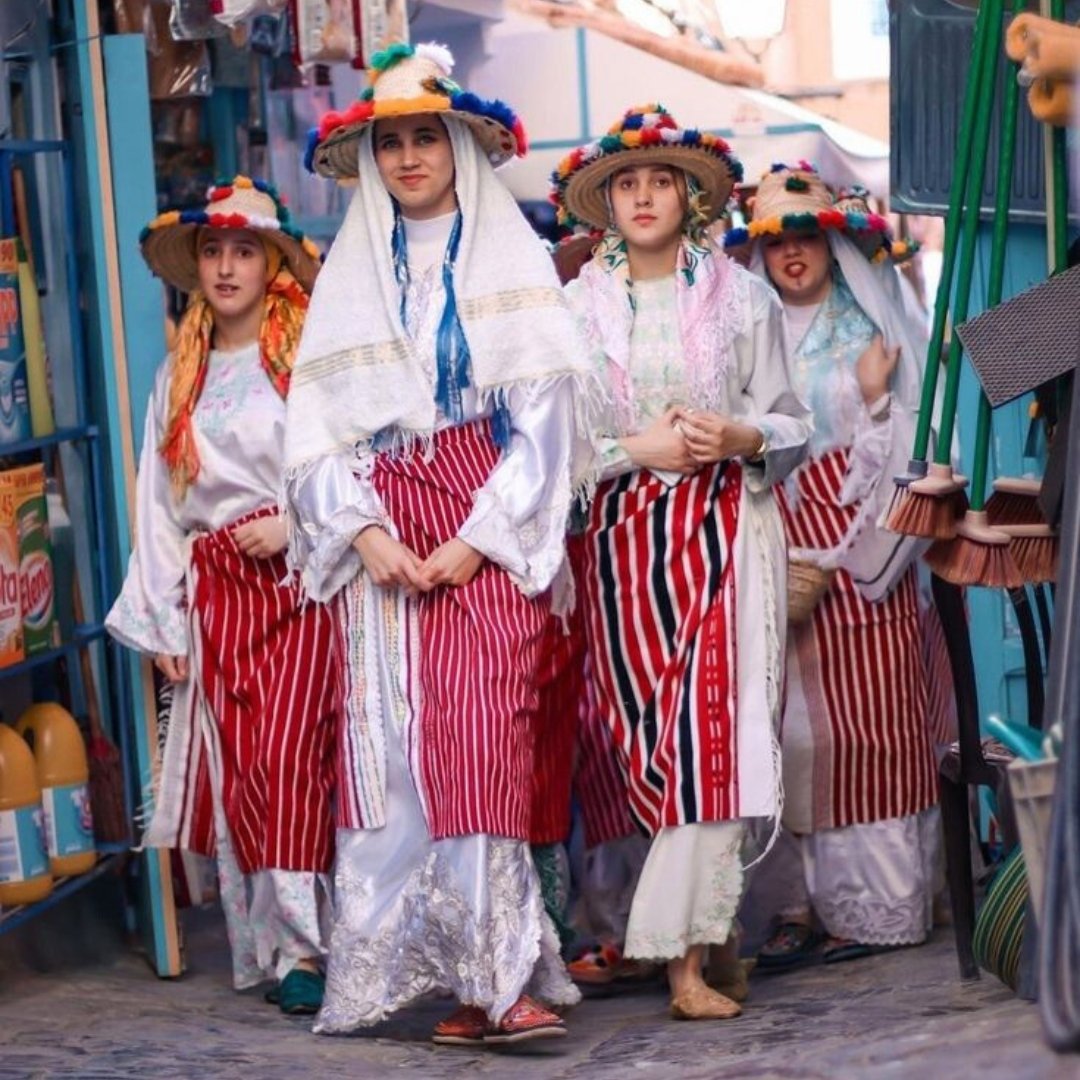

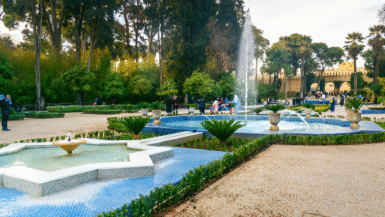
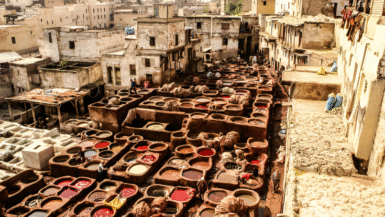
Leave a reply